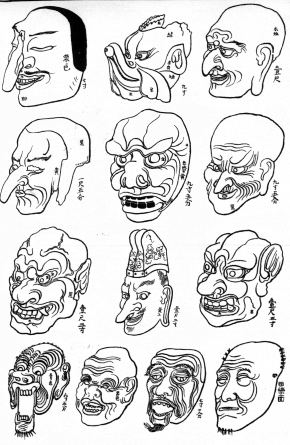 | ||
Gigaku (伎楽), also known as kure-gaku (呉楽) refers to an extinct genre of masked drama-dance performance, imported into Japan during the Asuka period.
Contents
History
Records state that it was introduced during the 20th year of reign of Empress Suiko (612.) by a certain Mimaji (Mimaji (味摩之)) from Kudara kingdom (Baekje), one of the Three Kingdoms of Korea.
The masked dance was performed in silent mime, to the accompaniment of music. The flute, waist drum (or hip drum; (yōko (腰鼓)), also known as kuretsuzumi (呉鼓, "Wu(China) drum")), and shōban (鉦盤), a type of gong, were the three instruments used in the Nara Period, though the gong was superseded by a type of cymbal (dobyōshi (銅鈸子)) in the early Heian Period (9th century).
About the only surviving description of the performance comes from the musical treatise forming a part of the Kyōkunshō (『教訓抄』; "Selections for Instructions and Admonition" ) authored by Koma no Chikazane (died 1242). According to this, the netori or tuning of instruments signals the start, followed by a prelude of instruments. Then there is a parading of the whole cast, both dancers and instrumentalists. It has been speculated that the character mask named Chidō (治道) "Govern the way" probably took position at the front of the parade, especially as this mask is listed first off in the assets ledgers (Shizaichō (資材帳)) for some of the temples that house gigaku masks. The program opens with the Lion Dance (Shishimai), and solo dances by the Duke of Wu, wrestler, the birdman karura, and the Brahman priest.
There are two wrestler archetype characters, the Kongō (金剛) or "Vajra-yakṣa" who is open-mouthed, and the Rikishi (力士) who is closed mouthed. These two are said to be analogous to the two Niō or guardian gate statues, who respectively form the open and closed A-un shapes in their mouths.
With the exaggerated features of many of the masks, the content of the play is described as being farcical. Indeed, the two-part play of the Kuron (崑崙) (or Konron; Chinese:Kunlun nu which denotes a black man or negrito) and the Rikishi (wrestler or "Strong Man") is outright obscene.
In the ribald performance, the lascivious Kuron falls in lust for the Gojo (Wu woman or Chinese maiden), and expresses his desire by holding up his phallic prop called marakata (陽物(マラカタ)), and beating it with his hand fan. The comic dance maneuvers are referred to as marafuri-mai (マラフリ舞, "phallus-swinging dance"). In subsequent development, the Kuron is subdued by the Rikishi who binds the Kuron by his equipment (marakata), and drags him along by the noose around his manhood.
The gigaku is closely related to sangaku (散楽), and may be considered a variant imported via the Korean route, rather than more directly from China.
